How Much Do Pharmaceutical Companies Spend On Research

Pharmaceutical research refers to the systematic investigation and study of drugs and medications to discover, develop, and evaluate new pharmaceutical products. This research is essential for advancing medical science, improving healthcare, and treating various diseases and conditions. Pharmaceutical research involves a series of stages, each with its own objectives and methodologies. Here are some key aspects of pharmaceutical research:
- Drug Discovery: This is the initial phase where researchers identify potential drug candidates. It often involves extensive laboratory work, including testing compounds on cells, tissues, or animals to assess their potential therapeutic effects.
- Preclinical Studies: Before testing a drug on humans, preclinical studies are conducted to evaluate its safety, toxicity, and effectiveness in animals. These studies help researchers understand how the drug behaves in living organisms and identify potential risks.
- Clinical Trials: Clinical trials are critical for testing new drugs or treatments in human volunteers. They are conducted in different phases (Phase I to Phase IV) and are carefully designed to assess the drug’s safety, efficacy, dosage, and potential side effects.
- Regulatory Approval: After successful clinical trials, researchers submit their findings to regulatory agencies (e.g., FDA in the United States, EMA in the European Union) for approval to market and sell the drug. The regulatory agencies review the data to ensure the drug’s safety and effectiveness.
- Post-Marketing Surveillance: Even after a drug is approved and available on the market, pharmaceutical research continues. Post-marketing surveillance monitors the drug’s safety and collects additional data on its long-term effects in larger populations.
- Comparative Effectiveness Research: This type of research compares different treatments or drugs to determine which one is more effective for a particular condition. It helps guide healthcare decisions and optimize treatment choices.
- Pharmacovigilance: This aspect involves ongoing monitoring of approved drugs to detect and assess any adverse effects or unexpected reactions.
Pharmaceutical research is a dynamic and collaborative field that involves the efforts of various stakeholders, including scientists, medical professionals, regulatory authorities, pharmaceutical companies, and patient advocacy groups. The ultimate goal of pharmaceutical research is to improve patient outcomes, enhance quality of life, and contribute to advancements in medical knowledge and treatment options.
Who funds pharmaceutical research?
Pharmaceutical research is primarily funded by a combination of public and private sources. The funding sources can vary depending on the type of research, the stage of drug development, and the location of the research institution. Here are some of the main funding sources for pharmaceutical research:
1. Pharmaceutical Companies: The pharmaceutical industry is a major contributor to funding pharmaceutical research. Pharmaceutical companies fund a significant portion of drug discovery, development, and clinical trials. These companies invest in research to identify potential drug candidates, conduct preclinical studies, and conduct extensive clinical trials to test the safety and efficacy of new medications.
2. Government Agencies: Public funding from government agencies plays a crucial role in supporting pharmaceutical research. National institutes and agencies, such as the National Institutes of Health (NIH) in the United States, the European Commission in the European Union, and the Medical Research Council (MRC) in the United Kingdom, provide substantial financial support for research projects that aim to advance medical knowledge and improve public health.
3. Non-Profit Organizations: Non-profit organizations and foundations, such as the Bill & Melinda Gates Foundation, the Wellcome Trust, and the American Cancer Society, are significant contributors to pharmaceutical research funding. These organizations often focus on specific diseases or global health issues and provide grants and funding to support research efforts.
4. Academic Institutions: Universities and research institutions also play a crucial role in funding pharmaceutical research. They often receive grants from government agencies, private foundations, and industry partnerships to conduct research projects and clinical trials.
5. Venture Capital and Private Equity: Early-stage research and development in the pharmaceutical industry often rely on funding from venture capital and private equity firms. These investors provide capital to support the development of promising drug candidates and biotechnology startups.
6. Collaborative Partnerships: Pharmaceutical research is frequently conducted through collaborative partnerships between academia, industry, and non-profit organizations. These partnerships often involve joint funding efforts to address specific research questions or medical needs.
7. Licensing and Royalties: In some cases, pharmaceutical research is funded through licensing deals and royalties. Universities and research institutions may license their intellectual property and discoveries to pharmaceutical companies in exchange for financial support or future royalties from successful drug development.
8. Public Donations: In certain cases, pharmaceutical research projects may receive funding from public donations and crowdfunding initiatives. These sources of funding are particularly common for research related to rare diseases or conditions with strong public support.
The funding landscape for pharmaceutical research is diverse, with a mix of public and private stakeholders contributing to the advancement of medical science and the development of new drugs and treatments. The collaborative efforts between these various funding sources are crucial for addressing global health challenges and improving patient outcomes.
How Much Do Pharmaceutical Companies Spend On Research
The cost of research and development is a major expense for pharmaceutical companies, as they invest heavily in discovering and developing new drugs and therapies.
On average, large pharmaceutical companies with substantial R&D pipelines and global operations may allocate anywhere from 15% to 20% of their total revenue to research and development. This percentage can fluctuate from year to year based on the progress of ongoing projects, regulatory requirements, and the success or failure of clinical trials.
For example, some of the largest pharmaceutical companies in the world, such as Pfizer, Novartis, and Merck & Co., have historically spent billions of dollars annually on research and development. In contrast, smaller biotechnology firms or companies specializing in niche areas may dedicate a higher percentage of their revenue to R&D to focus on a limited number of projects.
It’s important to note that the cost of research and development varies significantly depending on the phase of drug development. Early-stage research and preclinical studies tend to be less expensive than the clinical trials required for regulatory approval. Clinical trials can be particularly costly due to the need to enroll large patient populations, comply with strict regulatory requirements, and ensure patient safety.
Additionally, the complexity of developing different types of drugs, such as small molecules, biologics, or gene therapies, can influence the cost of research and development.
Do pharmaceutical companies spend more on advertising than research?
Pharmaceutical companies’ spending on advertising and research can vary widely from company to company and depend on multiple factors. It’s essential to understand that different companies might allocate their budgets differently based on their specific strategies, product portfolios, and market competition.
That being said, historically, some pharmaceutical companies have been criticized for allocating a significant portion of their budgets to marketing and advertising rather than research and development. The reasoning behind this approach is that investing in marketing can help drive product sales, while research and development can be costly and time-consuming, with uncertain outcomes.
Pharmaceutical advertising can take various forms, including direct-to-consumer advertising (DTCA) and marketing efforts targeted at healthcare professionals. DTCA, in particular, has been a subject of debate due to concerns about its impact on patient behavior and healthcare costs.
On the other hand, research and development costs are substantial, especially for innovative drugs and treatments. Developing a new drug from initial discovery to regulatory approval can take over a decade and cost billions of dollars. These costs include preclinical studies, clinical trials, regulatory submissions, and post-marketing surveillance.
However, it’s worth noting that pharmaceutical companies’ spending on research and development can be influenced by factors such as patent expirations, competition, and the overall research pipeline. Additionally, some pharmaceutical companies that focus on niche or rare disease areas may dedicate a more substantial portion of their budget to research. It is essential to consider that the allocation of spending in pharmaceutical companies can change over time and may differ across companies.





